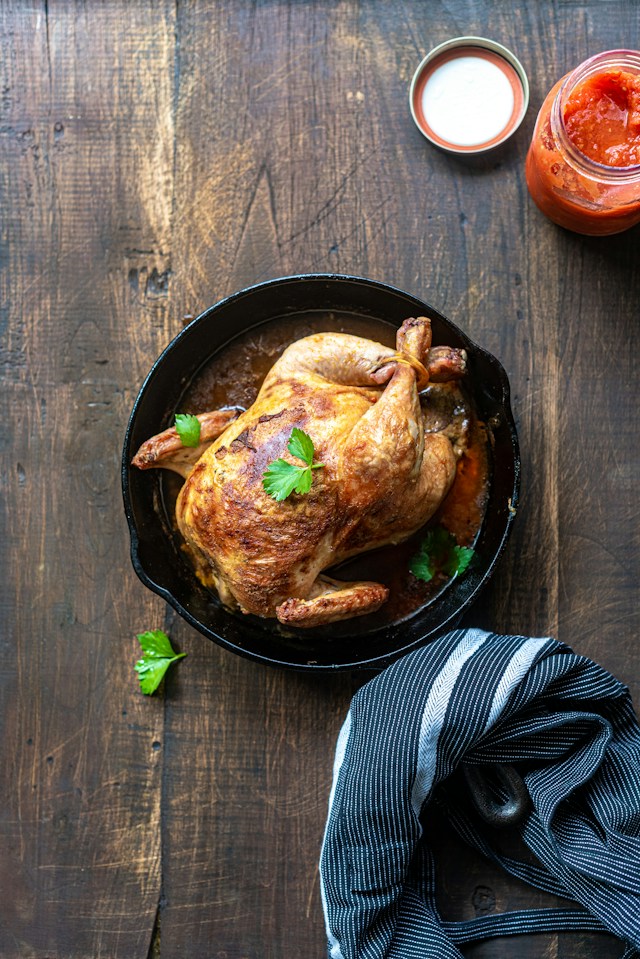What’s the trick to getting crispy skin on roast chicken?

The tantalizing aroma of a roast chicken wafting through the air is a familiar and comforting scent in many households. The anticipation builds as the bird sits in the oven, its skin slowly transforming from a pale yellow to a golden brown. When you finally carve into it, the perfect roast chicken promises juicy meat underneath a layer of crispy skin. But achieving that ideal balance of textures isn’t always easy. In this article, we will serve up some secrets to help you perfect the art of roasting a chicken to crispy-skinned perfection.
The Preparation: Laying the Groundwork for Crispy Skin
Before you even switch on the oven, you need to properly prepare the chicken. The key here is to ensure the skin of the bird is as dry as possible. Start by patting the chicken dry using clean kitchen towels or paper towels.
Avez-vous vu cela : How can you create a perfectly balanced cobb salad?
Next, generously season your chicken. Salt is a critical ingredient in this process. It not only imparts flavor to the meat, but it also helps to draw out moisture from the skin, making it more prone to crisping. You can rub the salt all over the chicken, including inside the cavity.
Some recipes also recommend letting the chicken sit in the refrigerator for a few hours or overnight, uncovered. This process, referred to as "dry brining," allows the salt to penetrate deep into the meat while aiding in further drying out the skin.
Avez-vous vu cela : What’s the secret to delicious gluten-free muffins?
The Roasting Pan: Choosing and Preparing the Right Vessel
When it comes to roasting, the choice of pan can significantly impact your bird’s crispiness. A shallow roasting pan is ideal because it allows more air circulation around the chicken, contributing to a more uniform browning.
Before you place your bird in the pan, consider adding a layer of chopped vegetables like carrots, onions, and celery. This serves a dual purpose. It elevates the chicken, allowing heat to circulate more evenly, and the vegetables can absorb the chicken’s drippings, preventing them from making the oven smoky and burning on the pan.
To ensure the chicken doesn’t stick to the pan, lightly oil the bottom before placing your bird. Using oil helps to kickstart the browning process while keeping the bird from sticking.
The Oven: Perfecting the Art of Roasting
Now that your chicken is prepared and your pan is ready, it’s time to get roasting. Preheat your oven to a high temperature — 450°F (230°C) is typically recommended. Roasting the chicken at a high heat for the first few minutes allows the skin to start crisping up.
After about 15-20 minutes, reduce the oven temperature to around 375°F (190°C). This lower temperature will ensure that the chicken cooks through without burning the skin. The total roasting time will depend on the size of your bird, but as a rule of thumb, a 4-5lb chicken will usually take about an hour and a half.
Temperature Check: Ensuring Perfectly Cooked Meat
While a beautifully browned and crispy skin is an important part of a roast chicken, you also want to ensure that the meat underneath is cooked to perfection.
The best way to do this is by using a meat thermometer. Insert the thermometer into the thickest part of the bird – typically the thigh – making sure not to touch the bone. A perfectly cooked chicken should register 165°F (74°C).
Post-roasting Procedure: The Importance of Resting
Once your chicken is cooked to the perfect temperature, resist the urge to carve it immediately. Let it rest for at least 15-20 minutes. This resting time allows the juices to redistribute throughout the meat, making it moist and tender.
While your chicken rests, you can use this time to make a quick pan sauce with the drippings. This is a great way to add another layer of flavor to your meal and is a fantastic accompaniment to your perfectly roasted, crispy-skinned chicken.
Remember, achieving the perfect roast chicken with crispy skin isn’t about fancy ingredients or complicated techniques. It’s about understanding the fundamentals of cooking — from the way you prepare your bird and your roasting pan, to how you control and check your oven temperature. With a little bit of practice and patience, you’ll soon be serving up roast chicken that’s not only aromatic and flavorful but also boasts a beautifully crispy, golden brown skin.
The Secret Ingredient: Baking Powder for an Extra Crispy Roast
A little-known trick to getting the most crispy skin on your roast chicken involves a simple ingredient you probably have in your pantry right now: baking powder. Yes, you read it right. Baking powder isn’t just for fluffy pancakes or towering biscuits; it’s also a fantastic tool in achieving a crispy roast chicken.
The science behind this trick lies in the baking powder’s ability to raise the skin’s pH level, which helps it brown more effectively. It also creates tiny bubbles on the chicken skin that increase its surface area, allowing it to become even more crispy.
To use baking powder in your chicken recipe, mix it with kosher salt and black pepper – about 1 part baking powder to 3 parts salt. Rub this mixture all over the chicken after you’ve dried the skin and before you let it rest in the fridge. As with the salt alone, you can leave the chicken with the baking powder mixture in the refrigerator for a few hours or overnight to accomplish a truly crispy chicken.
Then, place the chicken in the roasting pan, and follow the same roasting procedure – starting high at 450°F for about 15-20 minutes, then reducing to 375°F until done.
The Finishing Touch: Olive Oil for a Golden Glow
Olive oil may seem like an unlikely ingredient in achieving a crispy roast, but it plays a crucial role in helping to seal in the chicken’s natural juices and adding a delectable golden glow to the skin.
Before you place the chicken in the oven, lightly brush the skin with olive oil. This gives the skin an extra layer of fat that will help it to brown evenly and become crispy. Olive oil will not only contribute to the crispness of the skin but also give it a beautiful, appetizing color.
Remember to keep a close eye on the chicken at the start of roasting. The combination of baking powder and olive oil can cause the skin to brown quickly. If it’s getting too dark, simply tent the bird with some aluminum foil.
Conclusion: The Ultimate Crispy-Skinned Roast Chicken
Achieving the perfect roast chicken with a crispy skin is a blend of art and science, precision and intuition. From the proper preparation of the bird, choice of roasting pan, control of oven temperature, secret application of baking powder, to the final brush of olive oil, every step contributes to the final result.
The most vital aspect to remember is the importance of patience. Whether it’s allowing the bird to dry out in the fridge, waiting for the oven to reach the correct temperature, or resisting the urge to carve the chicken immediately after it’s out from the oven, patience truly is a virtue when it comes to achieving a beautifully roasted chicken with crispy skin.
With these tips and tricks up your sleeve, you’re now equipped to create a roast chicken that is not only juicy and flavorful but also boasts a skin that’s wonderfully crispy and golden. It’s your turn now, head to the kitchen and let the aroma of a perfectly roasted chicken fill your home.
